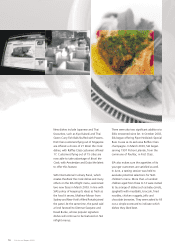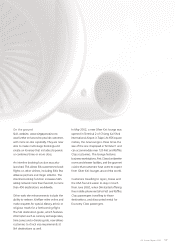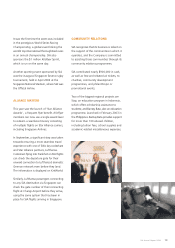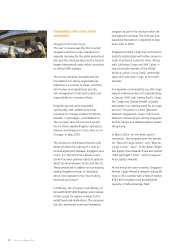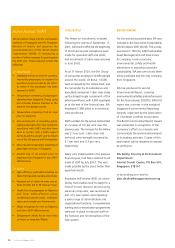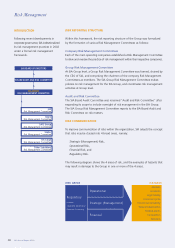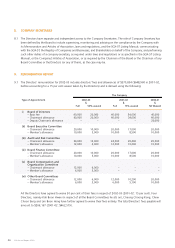Singapore Airlines 2003 Annual Report Download - page 28
Download and view the complete annual report
Please find page 28 of the 2003 Singapore Airlines annual report below. You can navigate through the pages in the report by either clicking on the pages listed below, or by using the keyword search tool below to find specific information within the annual report.
SIA Annual Report 02/03
26
OUR PEOPLE
The freeze on recruitment, initiated
following the events of September 11,
2001, remained in effect at the beginning
of the financial year. Exceptions were
made for specialist staff and pilots,
and recruitment of cabin crew resumed
in June 2002.
As at 31 March 2003, the SIA Group
of companies employed 30,680 people
around the world. Of these, 14,580
were employed by the Airline itself, and
the remainder by its subsidiaries and
associated companies. Cabin crew made
up the largest single component of the
airline’s workforce, with 6,891 employed
as at the end of the financial year. SIA
employed 1,888 pilots in its technical
crew workforce.
Staff numbers for the Group represented
an increase of 3.6 per cent over the
previous year. The increase for the Airline
was 2.3 per cent. Cabin crew and
technical crew strength increased by
3.7 per cent and 6.3 per cent,
respectively.
Salary cuts, implemented in the previous
financial year, had been restored to all
levels of staff by July 2002. This was
made possible by the year’s better than
expected results.
Employee Self-Service (ESS), an online
facility that enables staff to apply for a
host of human resource services using
personal computers, was launched as
part of a new system encompassing
a wide range of administrative and
organizational functions. Comprehensive
training and communication programmes
were put in place to educate staff on
the features and functionalities of the
new system.
ENVIRONMENT
For the second successive year, SIA was
included in the Dow Jones Sustainability
World Indexes (DJSI World). This survey,
launched in 1999 by SAM Sustainable
Asset Management and Dow Jones
& Company, covers economic,
environmental, safety and health
dimensions in assessing corporate
sustainability. SIA was one of only three
airlines selected and the only company
from Singapore.
SIA has produced its second
Environmental Report, covering
environmental activities and performance
for the financial year 2002/03. SIA’s first
report was a winner in the inaugural
Singapore Environmental Reporting
Awards, organized by the Association
of Chartered Certified Accountants.
The Best Environmental Report Award
was presented in recognition of the
Company's efforts to measure and
communicate the environmental impact
of its trading activities. Copies of this
year’s report can be obtained on request
by writing to:
SIA Safety, Security & Environment
Department
Airmail Transit Centre, PO Box 501,
Singapore 918101
or by sending an e-mail to:
alex_desilva@singaporeair.com.sg
Action Against SARS
SIA has worked closely with the Civil Aviation
Authority of Singapore and the Singapore
Ministry of Health, and observed the
recommendations of the World Health
Organization (WHO), in introducing a
number of safety measures to guard against
the SARS virus. These measures include the
following:
On the ground
•Displaying notices at check-in counters,
requesting passengers to respond to
questions recommended by the WHO,
to check if the passenger has been
exposed to SARS.
• Temperature screening of passengers
departing from Singapore Changi, using
non-intrusive thermal scanners at the
airport’s immigration points.
• Temperature screening of all air crew
prior to departure.
• Announcements at boarding gates,
urging passengers who have symptoms
associated with SARS and who have
been in contact with a SARS suspect
not to board the aircraft, and to inform
one of the SIA ground staff immediately.
•Non-intrusive temperature screening of
passengers arriving in Singapore.
•Disinfecting of all aircraft prior to
departure from Singapore or any SARS-
affected area.
On board
•High-efficiency particulate-arresting air
filters that trap dust, bacteria and viruses.
• Replacement of cabin air every two or
three minutes (20 to 30 times an hour).
•Health kits for passengers on flights to
and from SARS-affected areas,
containing surgical masks, antiseptic
wipes and a single-use thermometer.
•Masks and gloves for crew on flights to
and from SARS-affected areas.
•Temperature checks for air crew every
six hours on long-haul flights.


